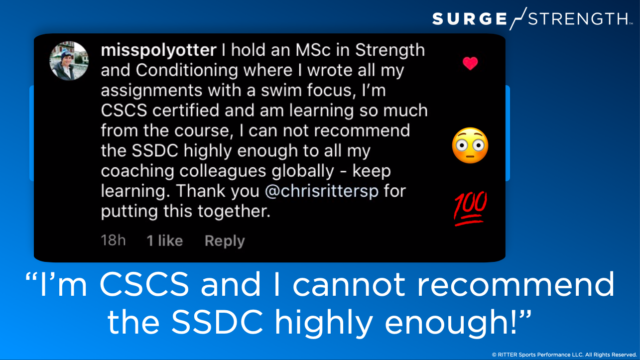When coaches don’t have dryland assessments for swimmers, it tends to result in random exercise selection without any progress towards a long-term goal. Sometimes, this works for a while. Eventually though, these athletes are likely to plateau or get injured. The way to prevent this from happening is to use assessments in order to create a roadmap for dryland programming. The results of an assessment give coaches a compass for future exercise programming. It’s the simple concept of “if you don’t know where you’re are starting, it’s hard to get where you want to go.” Assessments let you know where each athlete is starting. Therefore, you can base dryland programming off assessment results. Assessments provide a reference point for coaches and help them decide where to aim their focus within their dryland plan.
Which Exercises Should Coaches Use for Dryland Assessments for Swimmers?
Assessments gather data by using a few basic exercises to represent large categories of training. For example, a vertical jump test is a simple and effective way of testing power. There are many studies that show how an improved vertical jump is correlated to improved power. So, when choosing exercises to assess, we want to highlight the movements that give us the most information about our athletes.
When assessing strength, we can look at the 5 main categories of movement: push, pull, hinge, squat, and brace. Then, we can select 1 basic exercise from each category to represent the athlete’s physical strength and ability in that movement pattern.
SURGE Strength’s Bridge Dryland Assessment for Swimmers Protocol
Let’s take a closer look at SURGE Strength’s Bridge Combo test. This test is one of our top three assessment recommendations. Coaches know how overwhelming it can be to have twenty options for assessments, so we break it down into our favorite few. The Bridge Combo test is designed to assess an athlete’s ability to brace their core in a plank position. The test is a total of 2 minutes and 30 seconds, given that the athlete can sustain proper form in this position throughout the test. During the assessment, coaches ask the athlete to lift an arm or a leg for short increments of time. To see a bridge combo test be performed in real time, see the video below.
This total body assessment gives coaches a significant amount of information. Not only does it highlight the athlete’s core strength, but it also reveals their shoulder stability, hip stability, and ability to integrate their upper and lower body together. In addition, it breaks down the brace movement pattern and conveys further information to the coach about the athlete’s weak points in the body. It also tells the athlete which side of the body is more stable. To get swim specific, it even shows the effects of the athlete’s breathing pattern tendencies when one side is significantly more stable than the other.
Objective VS Subjective Dryland Assessments for Swimmers
When choosing an assessment, look for ways the test provides objective data as well as subjective data. Above, we talked about the subjective data coaches can obtain for the test. We see how athlete’s lean to one side during the test. We can warn athletes about their form based on their perception in real time. However, whoever conducts the test may have a slightly different interpretation of the test. On the other hand, objective data gives concrete information about the test.
In our Bridge Combo test, we use time as an objective measure for strength endurance. For instance, an athlete makes it halfway into the test before needing to come down the first time they test. Then, they make it to the end of the 2 minutes and 30 seconds upon retesting. The objective increase in time supports that the dryland program helped the athlete improve.
Objective data helps both the coach and the athlete attain unbiased data about their training. Finding a test that offers both subjective and objective data, like our example above, gives you an advantage when deciding where each athlete falls on the spectrum of exercise progression for that given movement category.
How Often Should We Reassess?
Assessments aren’t meant to be completed one time and forgotten the rest of the season. Instead, they act as a reference point. They pinpoint where athletes are on the map at any point in the season. Therefore, we recommend testing at the beginning of season, mid-season, and at the end of season at a minimum. If you see that assessments are improving, you’re likely on the right path with dryland. If you see that assessments results are decreasing, you know it’s time to reassess your plan or reach out for help.
How to Eliminate Confounding Variables for Reliable Testing
In order to have repeatable and reliable exercise assessments, it is important to eliminate the possibility of confounding variables. Some common ways to keep testing consistent are:
- Testing at the same time of day and in the same location when possible.
- Performing tests after a consistent warm-up but before a dryland session.
- Recording results the same way each time.
- For some tests, recording multiple attempts and taking an average or best score.
- Videoing the tests to help you remember how you did it last time.
Using Dryland Assessments for Swimmers to Direct Programing
Once you’ve gathered all the data, it’s time to put together your dryland plan. The objective and subjective scores are used to determine which level of exercises each athlete is ready for. For example, if the athlete only holds the bridge in the Bridge Combo Test for <1 minute, their bracing exercises should come from the level 1 category. If they can hold the bridge for >1 min but cannot finish the test, they fall into level 2. If they can complete the test with proper form, they are ready for level 3 exercises. This is how assessments allow dryland to be individualized even when working with many athletes at one time.

Categorizing athletes based on these dryland assessments for swimmers will produce results. It also gives us a much more effective and efficient way to break up swimmers into groups for dryland. It also yields better results because each athlete is more appropriately matched to their exercise protocol. Ultimately, assessments take the guess work out of exercise programming. In turn, coaches can simply get back to coaching. The objective and subjective feedback from exercise assessments motivates both athletes and coaches, so that you don’t have to go into a big meet “guessing” that you got better. It also allows them to get more out of each dryland session. We highly recommend using the map and compass of dryland. After all, you won’t know where you’re going until you know where you currently stand.
NEW – AT HOME DRYLAND WORKOUT
GET IT FOR FREE BY ENROLLING IN THE SURGE STRENGTH ACADEMY
JOIN OTHERS FROM AROUND THE WORLD THAT ARE
BECOMING SURGE STRENGTH DRYLAND CERTIFIED (SSDC)

BECOME SURGE STRENGTH DRYLAND CERTIFIED (SSDC)
BUILD BETTER ATHLETES TO GENERATE FASTER SWIMMERS
Courtesy of SwimSwam’s exclusive dryland training partner, SURGE Strength.
SURGE Strength, a strength training brand created by Chris Ritter, CEO of RITTER Sports Performance, aims to build better athletes and faster swimmers through dryland programs, and coaching education.







